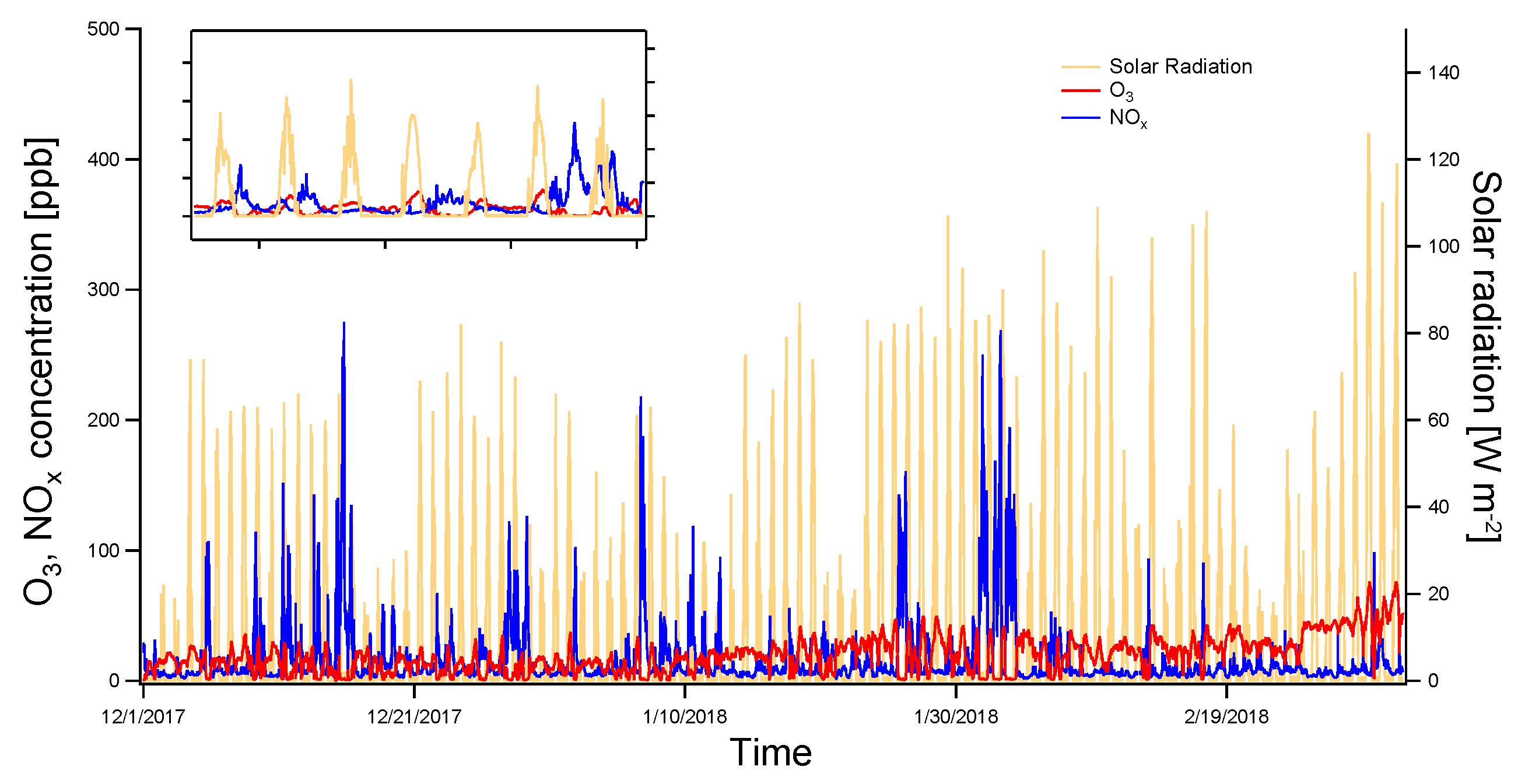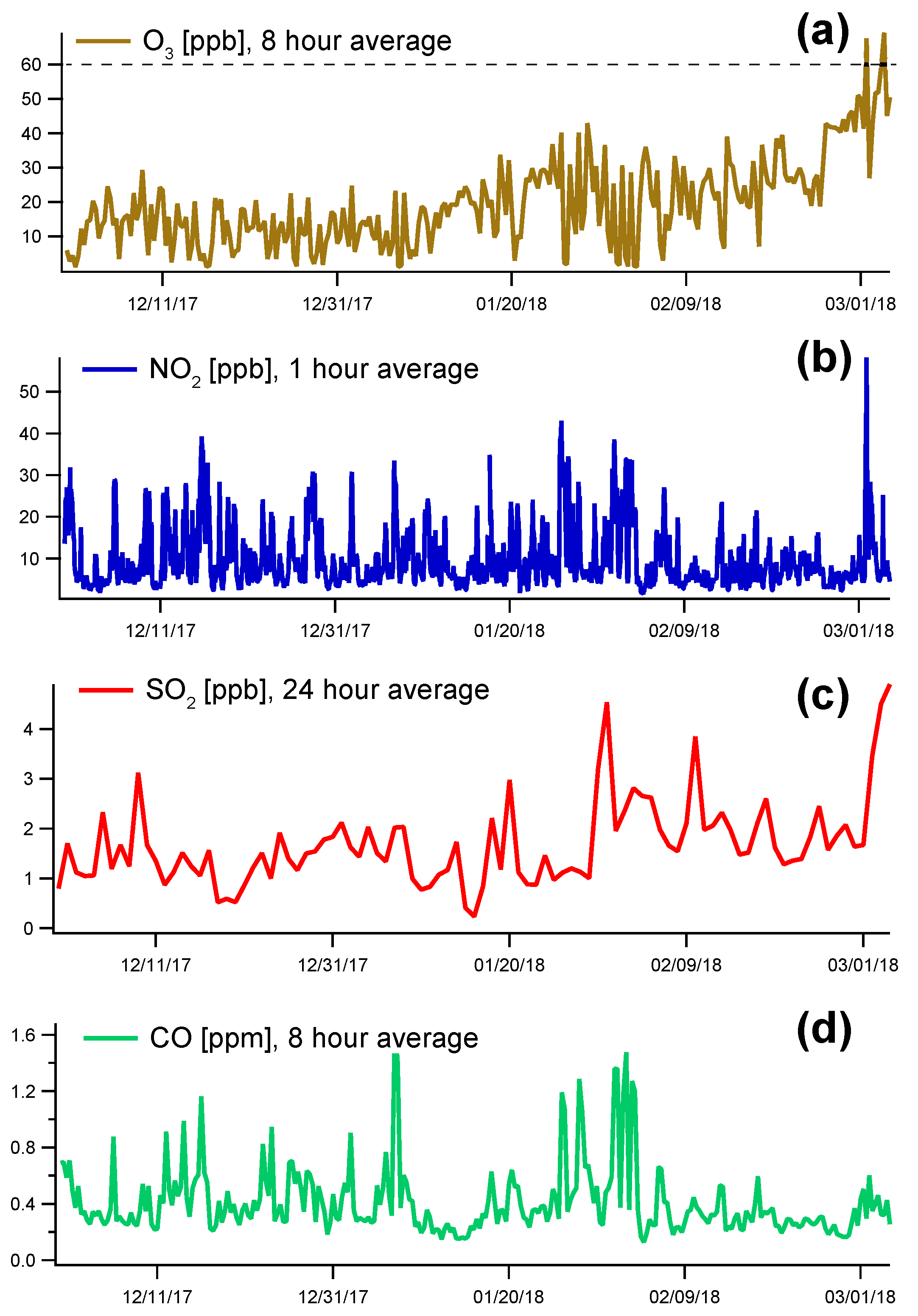Wintertime Variations of Gaseous Atmospheric Constituents in Bucharest Peri-Urban Area
Abstract
1. Introduction
2. Methodology
2.1. Measurement Site
2.2. Measurements
2.3. Data Treatment and Processing
3. Results
3.1. The Diurnal Behavior and Chemical Reactions
3.2. Assessment of Time Series Concentrations Relative to the European Regulations
4. Conclusions
Supplementary Materials
Author Contributions
Funding
Acknowledgments
Conflicts of Interest
References
- Solomon, S.; Qin, D.; Manning, M.; Chen, Z.; Marquis, M.; Averyt, K.B.; Tignor, M.; Miller, H.L. (Eds.) Climate Change 2007: The Physical Science Basis. Contribution of Working Group I to the Fourth Assessment Report of the Intergovernmental Panel on Climate Change; Cambridge University Press: Cambridge, UK; New York, NY, USA, 2007. [Google Scholar]
- Stocker, T.F.; Qin, D.; Plattner, G.-K.; Tignor, M.; Allen, S.K.; Boschung, J.; Nauels, A.; Xia, Y.; Bex, V.; Midgley, P.M. (Eds.) Climate Change 2013: The Physical Science Basis. Contribution of Working Group I to the Fifth Assessment Report of the Intergovernmental Panel on Climate Change; Cambridge University Press: Cambridge, UK; New York, NY, USA, 2013; p. 1535. [Google Scholar]
- IPCC. Global Warming of 1.5 °C. An IPCC Special Report on the Impacts of Global Warming of 1.5 °C Above Pre-Industrial Levels and Related Global Greenhouse Gas Emission Pathways, in the Context of Strengthening the Global Response to the Threat of Climate Change, Sustainable Development, and Efforts to Eradicate Poverty; Masson-Delmotte, V., Zhai, P., Pörtner, H.O., Roberts, D., Skea, J., Shukla, P.R., Pirani, A., Moufouma-Okia, W., Péan, C., Pidcock, R., et al., Eds.; IPCC: Geneva, Switzerland, 2018; in Press. [Google Scholar]
- COP24 Special Report. Health and Climate Change. In Proceedings of the 24th Conference of the Parties to the United Nations Framework Convention on Climate Change (COP24), Katowice, Poland, 2–15 December 2018; 38p. [Google Scholar]
- Montzka, S.A.; Dlugokencky, E.J.; Butler, J.H. Non-CO2 greenhouse gases and climate change. Nature 2011, 476, 43–50. [Google Scholar] [CrossRef] [PubMed]
- Boucher, O.; Randall, D.; Artaxo, P.; Bretherton, C.; Feingold, G.; Forster, P.; Kerminen, V.-M.; Kondo, Y.; Liao, H.; Lohmann, U.; et al. Clouds and Aerosols. In Climate Change 2013: The Physical Science Basis. Contribution of Working Group I to the Fifth Assessment Report of the Intergovernmental Panel on Climate Change; Stocker, T.F., Qin, D., Plattner, G.-K., Tignor, M., Allen, S.K., Boschung, J., Nauels, A., Xia, Y., Bex, V., Midgley, P.M., Eds.; Cambridge University Press: Cambridge, UK; New York, NY, USA, 2013. [Google Scholar]
- Crippa, M.; Janssens-Maenhout, G.; Guizzardi, D.; Van Dingenen, R.; Dentener, F. Contribution and uncertainty of sectorial and regional emissions to regional and global PM2.5 health impacts. Atmos. Chem. Phys. 2019, 19, 5165–5186. [Google Scholar] [CrossRef]
- Huszar, P.; Belda, M.; Halenka, T. On the long-term impact of emissions from central European cities on regional air quality. Atmos. Chem. Phys. 2016, 16, 1331–1352. [Google Scholar] [CrossRef]
- Pancholi, P.; Kumar, A.; Bikundia, D.S.; Chourasiya, S. An observation of seasonal and diurnal behavior of O3–NOx relationships and local/regional oxidant (OX = O3 + NO2) levels at a semi-arid urban site of western India. Sustain. Environ. Res. 2018, 28, 79–89. [Google Scholar] [CrossRef]
- Thimmaiah, D.; Hovorka, J.; Hopke, P.K. Source apportionment of winter submicron Prague aerosols from combined particle number size distribution and gaseous composition data. Aerosol. Air Qual. Res. 2009, 9, 209–236. [Google Scholar] [CrossRef]
- Adame, J.; Notario, A.; Villanueva, F.; Albaladejo, J. Application of cluster analysis to surface ozone, NO2 and SO2 daily patterns in an industrial area in Central-Southern Spain measured with a DOAS system. Sci. Total. Environ. 2012, 429, 281–291. [Google Scholar] [CrossRef]
- Clapp, L.J.; Jenkin, M.E. Analysis of the relationship between ambient levels of O3, NO2 and NO as a function of NOX in the UK. Atmos. Environ. 2001, 35, 6391–6405. [Google Scholar] [CrossRef]
- Apascariţei, M.; Popescu, F.; Ionel, I. Air pollution level in urban region of Bucharest and in rural region. In Proceedings of the 11th WSEAS International Conference on Sustainability in Science Engineering, Timişoara, Romania, 27–29 May 2009. [Google Scholar]
- Ionel, I.; Nicolae, D.; Popescu, F.; Talianu, C.; Belegante, L.; Apostol, G. Measuring air pollutants in an international Romanian airport with point and open path instruments. Rom. J. Phys. 2011, 56, 507–519. [Google Scholar]
- Popescu, F.; Ionel, I.; Lontis, N.; Calin, L.; Dungan, I.L. Air quality monitoring in an urban agglomeration. Rom. J. Phys. 2011, 56, 495–506. [Google Scholar]
- Antonescu, B.; Ştefan, S. The urban effect on the cloud-to-ground lightning activity in the Bucharest area. Rom. Rep. Phys. 2011, 63, 535–542. [Google Scholar]
- Mărmureanu, L.; Vasilescu, J.; Marin, C.; Ene, D. Aerosol source assessment based on organic chemical markers. Rev.Chim. 2017, 68, 853–857. [Google Scholar]
- Dandocsi, A.; Nemuc, A.; Marin, C.; Andrei, S. Measurements of aerosols and trace gases in southern Romania. Rev. Chim. 2017, 68, 873–878. [Google Scholar]
- Vasilescu, J.; Mărmureanu, L.; Nemuc, A.; Nicolae, D.; Talianu, C. Seasonal variation of the aerosol chemical composition in a Romanian peri-urban area. Environ. Eng. Manag. J. 2017, 16, 2491–2496. [Google Scholar]
- Mărmureanu, L.; Vasilescu, J.; Ştefănie, H.; Talianu, C. Chemical and optical characterization of submicronic aerosol sources. Environ. Eng. Manag. J. 2017, 16, 2165–2172. [Google Scholar] [CrossRef]
- Marin, C.; Stan, C.; Preda, L.; Marmureanu, L.; Belegante, L.; Cristescu, C.P. Multifractal cross correlation analysis between aerosols and meteorological data. Rom. J. Phys. 2018, 63, 805. [Google Scholar]
- Petit, J.-E.; Favez, O.; Albinet, A.; Canonaco, F. A user-friendly tool for comprehensive evaluation of the geographical origins of atmospheric pollution: Wind and trajectory analyses. Environ. Model. Softw. 2017, 88C, 183–187. [Google Scholar]
- Henry, R.; Norris, G.A.; Vedantham, R.; Turner, J.R. Source region identification using kernel smoothing. Environ. Sci. Technol. 2009, 43, 4090–4097. [Google Scholar] [CrossRef] [PubMed]
- Hobbs, P. Introduction to Atmospheric Chemistry; Cambridge University Press: Cambridge, UK, 2000; p. 262. [Google Scholar]
- Seinfeld, J.; Pandis, S. Atmospheric Chemistry and Physics: From Air Pollution to Climate Change, 2nd ed.; Wiley-Interscience: Hoboken, NJ, USA, 2006; p. 1152. [Google Scholar]
- Mazzeo, N.A.; Venegas, L.E.; Choren, H. Analysis of NO, NO2, O3 and NOx concentrations measured at a green area of Buenos Aires City during wintertime. Atmos. Environ. 2005, 39, 3055–3068. [Google Scholar] [CrossRef]
- WHO guidelines for indoor air quality: Selected pollutants. Geneva 2010 World Health Organization. Chapter 5–Nitrogen dioxide. In WHO Guidelines for Indoor Air Quality: Selected Pollutants; World Health Organization, Regional Office for Europe: Geneva, Switzerland, 2010; p. 484. [Google Scholar]
- Lee, U.; Han, J.; Wang, M. Evaluation of landfill gas emissions from municipal solid waste landfills for the life-cycle. J. Clean. Prod. 2017, 166, 335–342. [Google Scholar] [CrossRef]
- Lipman, T.; Delucchi, M.A. Emissions of nitrous oxide and methane from conventional and alternative fuel motor vehicle. Clim. Chang. 2002, 53, 477–516. [Google Scholar] [CrossRef]
- Bogner, J.; Spokas, K. Landfill CH4: Rates, fates, and role in global carbon cycle. Chemosphere 1993, 26, 369–386. [Google Scholar] [CrossRef]
- Zanis, P.; Monks, P.S.; Schuepbach, E.; Penkett, S.A. The role of in situ photochemistry in the control of ozone during Spring at the Jungfraujoch (3580 m asl)–Comparison of model results with measurements. J. Atmos. Chem. 2000, 37, 1–27. [Google Scholar] [CrossRef]
- Stone, D.; Whalley, L.K.; Heard, D.E. Tropospheric OH and HO2 radicals: Field measurements and model comparisons. Chem. Soc. Rev. 2012, 41, 6348–6404. [Google Scholar] [CrossRef] [PubMed]
- Isaksen, I.S.A.; Gauss, M.; Myhre, K.; Anthony, K.M.W.; Ruppel, C. Strong atmospheric chemistry feedback to climate warming from Arctic methane emissions. Glob. Biogeochem. Cycles. 2011, 25, GB2002. [Google Scholar] [CrossRef]
- Choi, H.D.; Liu, H.; Crawford, J.H.; Considine, D.B.; Allen, D.J.; Duncan, B.N.; Horowitz, L.W.; Rodriguez, J.M.; Strahan, S.E.; Zhang, L.; et al. Global O3—CO correlations in a chemistry and transport model. Atmos. Chem. Phys. 2017, 17, 8429–8452. [Google Scholar] [CrossRef]
- Voulgarakis, A.; Telford, P.J.; Aghedo, A.M.; Braesicke, P.; Faluvegi, G.; Abraham, N.L.; Bowman, K.W.; Pyle, J.A.; Shindell, D.T. Global multi-year O3-CO correlation patterns from models and TESsatellite observations. Atmos. Chem. Phys. 2011, 11, 5819–5838. [Google Scholar]
- Wang, Y.; Hao, J.; Mcelroy, M.B.; Munger, J.W.; Ma, H.; Nielsen, C.P.; Zhang, Y. Year round measurements of O3 and CO at a rural site near Beijing: Variations in their correlations. Tellus B 2010, 62, 228–241. [Google Scholar] [CrossRef]
- Reddy, M.S.; Venkataraman, C. Inventory of aerosol and sulphur dioxide emissions from India. Part II—Biomass combustion. Atmos. Environ. 2002, 36, 699–712. [Google Scholar] [CrossRef]
- Xu, W.Y.; Zhao, C.S.; Ran, L.; Lin, W.L.; Yan, P.; Xu, X.P. SO2 noontime-peak phenomenon in the North China Plain. Atmos. Chem. Phys. 2014, 14, 7757–7768. [Google Scholar] [CrossRef]
- Walker, H.L.; Heal, M.R.; Braban, C.F.; Ritchie, S.; Conolly, C.; Sanocka, A.; Dragosits, A.; Twig, G.M.M. Changing supersites: Assessing the impact of the southern UK EMEP supersite relocation on measured atmospheric composition. Environ. Res. Commun. 2019, 1, 041001. [Google Scholar] [CrossRef]
- Zou, Y.; Deng, X.J.; Zhu, D.; Gong, D.C.; Wang, H.; Li, F.; Tan, H.B.; Deng, T.; Mai, B.R.; Liu, X.T.; Wang, B.G. Characteristics of 1 year of observational data of VOCs, NOx and O3 at a suburban site in Guangzhou, China. Atmos. Chem. Phys. 2015, 15, 6625–6636. [Google Scholar] [CrossRef]





| Parameter Derived-Unit | Average Concentration for the Entire Period | Minimum Concentration for the Entire Period | Maximum Concentration for the Entire Period |
|---|---|---|---|
| (ppb) | 19.45 | 0.5 (detection limit) | 76 |
| (ppb) | 1.71 | 0.5 (detection limit) | 23 |
| NO (ppb) | 6.6 | 0.5 (detection limit) | 237 |
| (ppb) | 9.7 | 1.31 | 60 |
| (ppb) | 16.3 | 1 | 274 |
| CO (ppm) | 0.4 | 0.1 | 11 |
| (ppm) | 2.55 | 2.1 | 13 |
| Pollutant | Limit Concentration | Averaging Period | Accepted Exceedances per Year |
|---|---|---|---|
| 120 m (60 ppb) | maximum daily 8 h mean | 25 days in 3 years | |
| 125 m (47 ppb) | 24 h | 3 | |
| 350 m (134 ppb) | 1 h | 24 | |
| CO | 10 mg m (8 ppm) | maximum daily 8 h mean | N/A |
| 200 m (105 ppb) | 1 h | 18 | |
| 40 m (21 ppb) | 1 year | N/A |
© 2019 by the authors. Licensee MDPI, Basel, Switzerland. This article is an open access article distributed under the terms and conditions of the Creative Commons Attribution (CC BY) license (http://creativecommons.org/licenses/by/4.0/).
Share and Cite
Marin, C.A.; Mărmureanu, L.; Radu, C.; Dandocsi, A.; Stan, C.; Ţoancă, F.; Preda, L.; Antonescu, B. Wintertime Variations of Gaseous Atmospheric Constituents in Bucharest Peri-Urban Area. Atmosphere 2019, 10, 478. https://doi.org/10.3390/atmos10080478
Marin CA, Mărmureanu L, Radu C, Dandocsi A, Stan C, Ţoancă F, Preda L, Antonescu B. Wintertime Variations of Gaseous Atmospheric Constituents in Bucharest Peri-Urban Area. Atmosphere. 2019; 10(8):478. https://doi.org/10.3390/atmos10080478
Chicago/Turabian StyleMarin, Cristina Antonia, Luminiţa Mărmureanu, Cristian Radu, Alexandru Dandocsi, Cristina Stan, Flori Ţoancă, Liliana Preda, and Bogdan Antonescu. 2019. "Wintertime Variations of Gaseous Atmospheric Constituents in Bucharest Peri-Urban Area" Atmosphere 10, no. 8: 478. https://doi.org/10.3390/atmos10080478
APA StyleMarin, C. A., Mărmureanu, L., Radu, C., Dandocsi, A., Stan, C., Ţoancă, F., Preda, L., & Antonescu, B. (2019). Wintertime Variations of Gaseous Atmospheric Constituents in Bucharest Peri-Urban Area. Atmosphere, 10(8), 478. https://doi.org/10.3390/atmos10080478







